IDEX Online Research: Jewelry Price Inflation Continues to Moderate
March 23, 09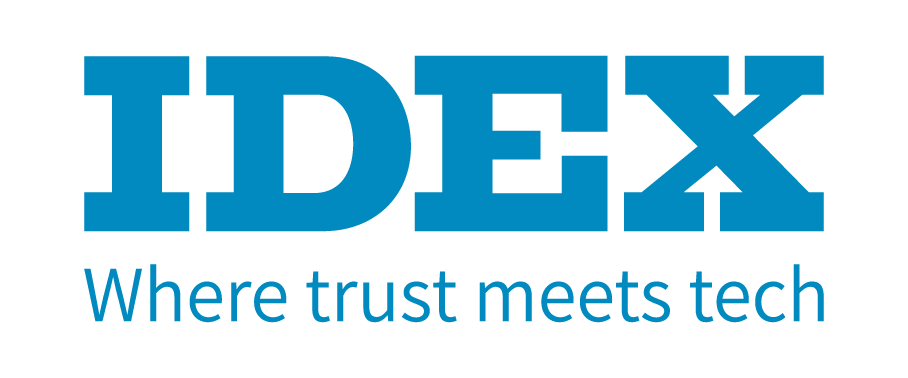
Suddenly, the talk on the street has been all about inflation. A year ago, inflation was very real. Then, along came a recession, and the talk turned to deflation. Since early 2009, the talk has turned back to inflation.
With interest yields declining, investors are running for inflation hedges – typically commodities. That’s pushed up the price of oil and other commodities, including gold, in the past couple of weeks.
Does anyone really know what comes next? Speculation by Wall Street suggests that inflation is real and here to stay. We probably don’t need to remind you that these are the same folks who got us into the recessionary mess we’re currently in. Do they know of what they speak? Only time will tell.
But we do know what’s happening in the jewelry industry: inflation has been cooling since mid-2008, both at the consumer level and the producer level. Only retail prices of watches continue to inch upward at a faster rate; other jewelry commodity prices have cooled, and are up minimally year-over-year. At the producer level, prices barely crept up, and the precious metals category posted a modest decline in prices.
With the sharp rise in gold prices over the past few weeks, inflation could return to the jewelry industry in 2009. Previously, we had predicted that weak demand would hold prices down, but if investors continue their run on commodities, inflation is just around the corner for jewelers.
Jewelry Price Inflation: February 2009
Here’s the summary of inflation at the jewelry retail and supplier level for the month of February 2009, as expressed as a percentage change year-over-year (February 2009 versus February 2008) in the U.S. market:
- Jewelry Producer Price Index +0.6 percent
- Precious Metals for Jewelry (0.8 percent)
-
- Jewelry & Watch Consumer Price Index +3.7 percent
- Jewelry CPI +3.6 percent
- Watch CPI +4.4 percent
-
At the retail level, the reported inflation number will likely moderate later in the second quarter, primarily because we will have anniversaried last year’s price increases that jewelers implemented in the second quarter. Comparisons in the first few months of 2009 versus the same period in 2008 reflect “old pricing” in 2008 versus “new higher prices” in 2009. In subsequent months in 2009, retail prices will be compared to the higher prices which were implemented in the second quarter of 2008. Since there have been no material retail price increases since mid-2008, inflation at the retail level in the U.S. market should remain modest. Even when demand recovers, we don’t look for any significant retail price increases. Merchants are going to be cautious before they implement new higher prices which might scare off their loyal customers.
Jewelry Producer Price Index (JPPI) +0.6 percent in February
 |
The following graph summarizes the monthly Jewelry Producer Price Index for inflation since early 2007. The percentage figures are based on year-to-year comparisons of the BLS Jewelry Producer Price Index (February 2009 versus February 2008).
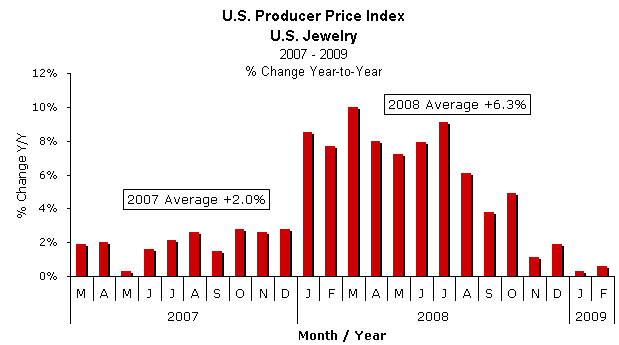
Source: BLS
Jewelry producer prices haven’t budged upward for several reasons, including the following:
- Retail jewelers have cut back on re-ordering merchandise. As a result, jewelry suppliers are offering a variety of price-based incentives to move merchandise into retailers’ stores. These price-based incentives are reflected in the modest inflation rate at the jewelry supplier level.
- There is still a large backlog of high-cost goods in the distribution pipeline that suppliers need to pass on to their customers. But the good news is that the pressure is off – suppliers’ costs have moderated, so they aren’t being forced to continue to raise prices in the face of a weakening environment of consumer demand.
- We believe that suppliers will likely hold off on any significant price increases near term for one key reason: retail jewelers simply won’t accept higher prices in the current recessionary environment.
- Because the wholesale community is so fragmented, no one supplier has pricing power. We’ve seen some panic pricing by suppliers who are trying to move goods – at a loss, if necessary – to raise cash. In that kind of environment, any supplier who tries to raise prices will lose business.
- Prices for both precious metal jewelry and gemstone jewelry have moderated. The graph below compares the JPPI (red bars) to inflation for precious metals (gold bars); gold had been the primary driver of precious metals inflation in 2007 and most of 2008. In January 2009, gold prices pulled back modestly, but have risen – and held steady at about $900 per ounce in February and March month-to-date. In our opinion, $900 gold has been priced into goods produced by jewelry manufacturers, and therefore producer prices aren’t likely to rise notably from current levels.
As the graph below illustrates, precious metals jewelry prices at the supplier level showed deflation in both January and February. Prices were down 0.8 percent.
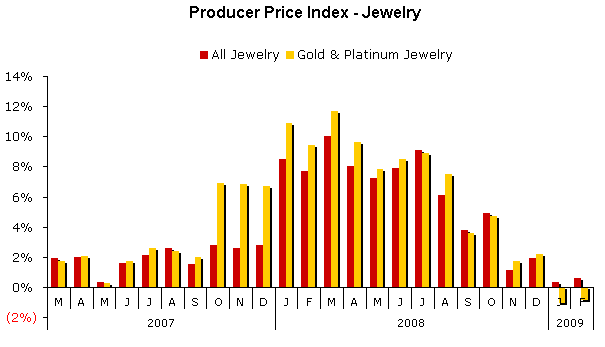
Source: BLS
We note, further, that producer price inflation in February – +0.6 percent – was dramatically below the retail price inflation rate for the entire jewelry category of +3.7 percent. Early in 2008, producer prices in the precious metals category rose more than the corresponding retail prices. As a result, retailers raised their prices in the second quarter of 2008. These trends illustrate the lag effect between rising producer prices and the resultant rising retail prices.
Jewelry Consumer Price Index (JCPI) +3.7 percent in February
U.S. jewelry consumer prices (JCPI) rose by 3.7 percent in February 2009, as calculated by the BLS. After rising sharply through the second quarter of last year, jewelry price increases at the retail level moderated in the late summer of 2008, a trend which continues. 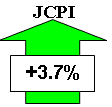
For the full year 2008, retail price inflation for jewelry in the U.S. market ran at an annual rate of +6.9 percent. Now, however, it appears that jewelry price inflation is moderating, and it will likely remain lower than 2008 in the coming months, especially as last year’s price increases that jewelers implemented in the second quarter of 2008 are anniversaried.
However, we note that jewelry price inflation at the retail level is still running well ahead of its two-decade annual gain of about +1.6 percent.
The graph below summarizes the percentage change in retail prices of jewelry and watches by month on a year-to-year basis since 2008. The percentage change is based on a comparison to the same month a year ago (February 2009 versus February 2008).
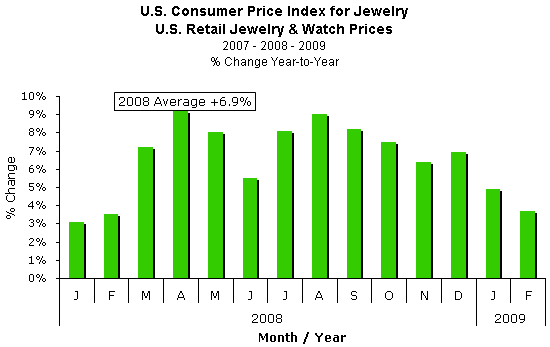
Source: BLS
Early in 2008, the components of jewelry and watch price inflation at the retail level reflected a disparity in price increases. Jewelry retail prices were up consistently during the first half of 2008, but watch retail prices showed virtually no price inflation. In the past few months, watch price inflation has steadily increased, though it moderated in January, only to pick up again in February. There were several factors which contributed to inflationary pricing trends of watches, including the following:
- Mechanical watch mechanisms from Switzerland were in short supply due to manufacturing capacity constraints.
- Demand for high-end watches and branded watches had been relatively strong, according to retail jewelers. However, demand for high-end watches during the 2008 holiday selling season was generally weak. Thus, the flames of inflation will no longer be fanned by demand and desire for these expensive watches.
The graph below illustrates the JCPI consisting of both jewelry and watch prices (green bars), jewelry prices only (red bars), and watch prices (yellow bars).
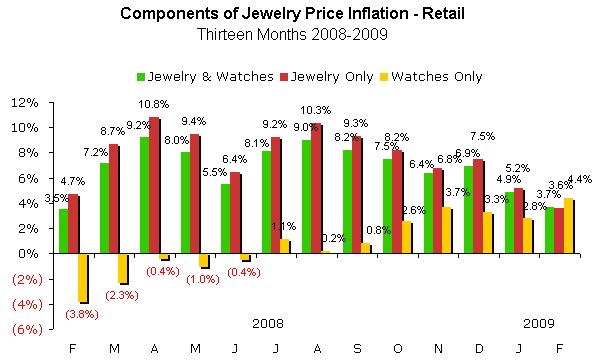
Source: BLS
Outlook: Modest Jewelry Price Inflation in 2009
After rising by nearly 7 percent in 2008, we continue to forecast more modest jewelry price inflation during 2009. The wild card, of course, is the price of commodities, including gold, silver, and platinum. If investors continue to buy these hedges against inflation, it will put upward pressure on jewelry prices. Our current prediction calls for 2009 price inflation to be in the low single digit level – a departure from our earlier forecast of modest deflation – but because it is so early in the forecast cycle, we’d call this little more than an educated guess tempered by historical trends.